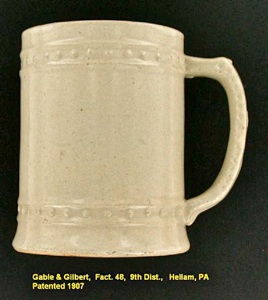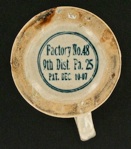Mugs and Bottles
A National Cigar History Museum Exclusive Exhibit
© Tony Hyman
Mug added March 31, 2010

Mugs and Bottles
A National Cigar History Museum Exclusive Exhibit
© Tony Hyman
Mug added March 31, 2010
Mugs and bottles have been popular novelty boxes since the 1870’s. Technically, they are uprights and can be seen in that exhibit but are gathered here for your convenience.
House of Windsor’s Winter Olympic Special, 1980
Very nice reusable mug offered in magazine ads by House of Windsor for $18 for a few months prior to the 1980 Lake Placid Olympics.
My wife and I attended the Olympics in Lake Placid and didn’t see them for sale at the event itself. The cigars originally set down inside the mug; I elevated them for the photo.
[9806]
Unidentified ceramic mug, c1910
These attractive mugs were packed with cigars by Joseph Weinrich, whose factory was located at 19 South Saint Clair Street in Dayton, Ohio, (Factory 495, 1st Ohio) but exactly when is not recorded (probably around 1910-1915).
The pottery factory is not known.

GOOD CHEER c1912
Less useful for drinking, but more decorative, is this c1912 tin can known to have been filled by at least two different cigar factories. This can was filled by D.C. Rose & Son, Factory 53 in Corvalis, Oregon.
A thumb cap, not visible in this picture, allows the lid to be flipped open like a beer stein.
[9804]
Unidentified glass beer mug c1908
Paneled glass beer mug patented in December of 1907 which originally held 25 cigars. Buy enuff “boxes” of these cigars and you could have a set of mugs, a useful bonus decades before depression era soap companies packed dishware and glasses in boxes of soap.
Cigars were made in Factory 531, 9th PA, who went out of business by 1910.
[9807]
Classic example of a silver plate bottle that is not
a retail cigar box. Most are engraved “Cigars” and
were originally sold in men’s stores, department
stores and tobacconists for a few dollars.
The top pulls off to reveal matches. The base
unscrews to become an ashtray. These were popular
during the last quarter of the 1800’s and still obtainable
during the first few decades of the 1900’s.
Photo courtesy of Jerry Terranova.
Items not in the NCM collection.
Country Club c1890
Lots of these silver plated bottles are around, made by a variety
of silver companies including Pairpoint. Very rarely were they
used as retail packages. This Bristol Plate Co. bottle was used
by L. Kahner (Fact. 65, 3rd NYC at 202 East 100th St.).
[2842] [2843]
Piper Heidsieck 1878
in name and form. The tops were originally foiled and wired like their namesakes. Cigars are
original, made in the small three-man Factory 976 3rd Dist NYC owned by Aaron Simmons at
128 East 109th St. for J. Holzman.
[2886] [2885]
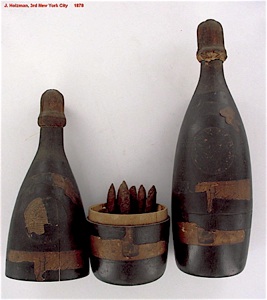
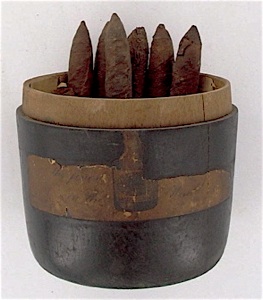
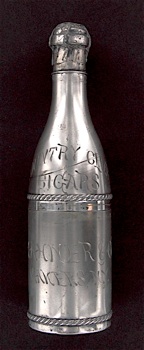
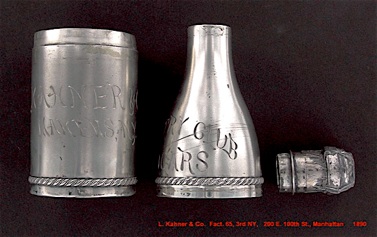
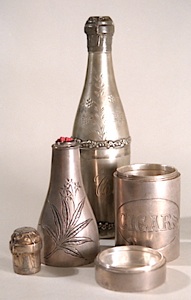

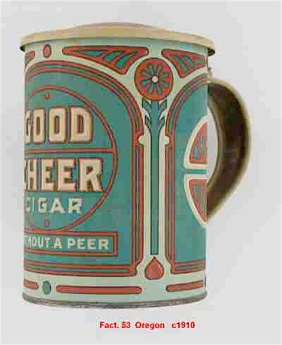
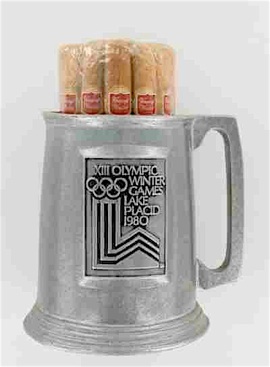
F.E. Fonseca’s aluminum bottle 1929
Packaging innovator F.E. Fonseca was one of at least three companies who chose this distinctive aluminum bottle to pack 25 cigars, each cigar wrapped in Japanese tissue and foil. Long back text describes the company’s tobacco and processes, and advertised their willingness to imprint custom names, photographs or emblems.
When the BLUE COMET train made its inaugural New Jersey run, they hired Fonseca to customize a label and foil for a commemorative bottle. The History Museum sold that bottle to a Blue Comet collector. Similar aluminum bottles were used by Canada’s Simon & Sons.
[9895] [9896]
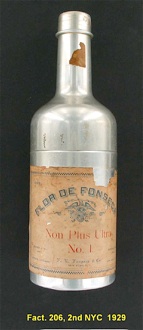
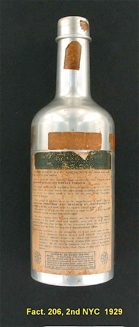
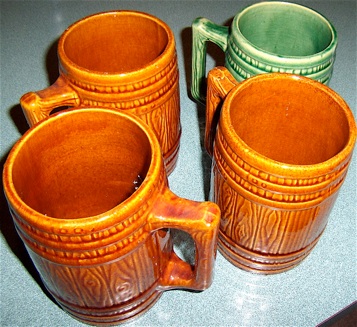

This plain clay-colored beer(?) mug was granted a patent in December of 1907. Used by cigarmakers Gable & Gilbert, Fact. 48, in the 9th Tax District, Hellam, PA. Customer
unknown. This is the earliest authenticated use of the mug shape to hold cigars.
